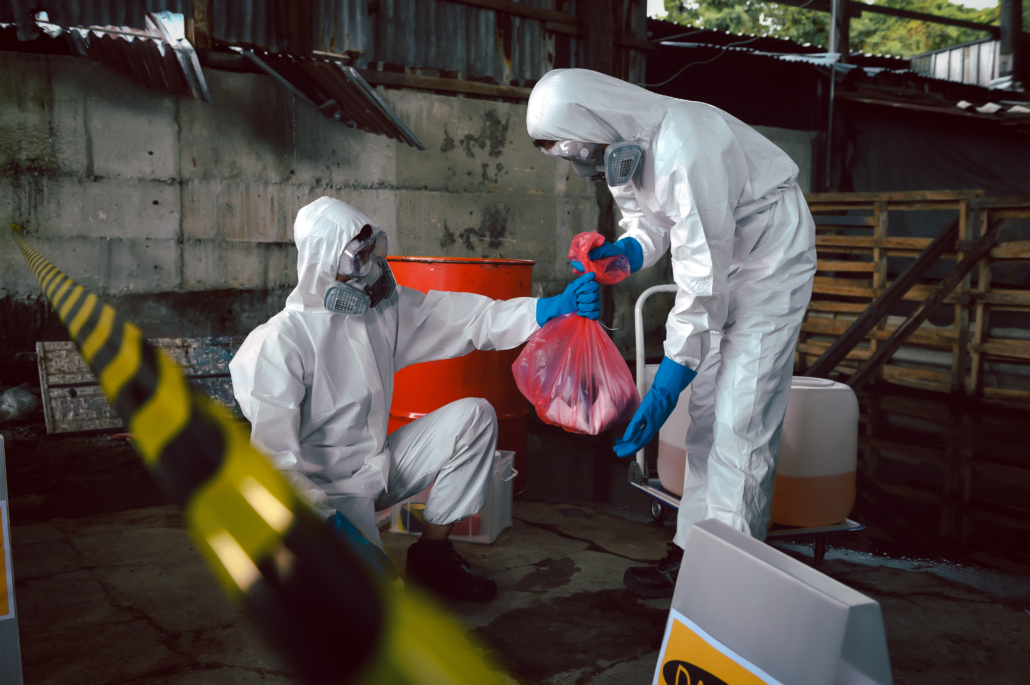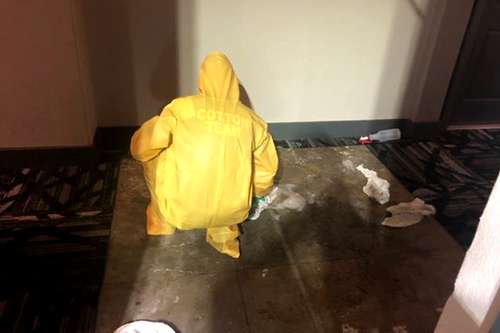Exact ATP Testing for Effective Sanitation and Hygiene Surveillance
Exact ATP Testing for Effective Sanitation and Hygiene Surveillance
Blog Article
Specialist Biohazard Cleaning and Purification for Blood, Bodily Fluids, and Hazardous Materials
The prospective wellness dangers associated with direct exposure to biohazards underscore the vital need for meticulous handling and extensive clean-up. As we browse the intricate landscape of biohazard clean-up, comprehending the subtleties of policies, compliance, and the specific tools at play becomes crucial in ensuring a extensive and safe purification process.
Wellness Threats of Biohazard Direct Exposure
Exposure to biohazards poses significant wellness dangers that can lead to severe consequences for communities and individuals alike. Biohazards encompass a variety of biological substances, consisting of blood, bodily liquids, mold, bacteria, infections, and other possibly contagious materials. When individuals enter into contact with these biohazards, whether with crashes, inappropriate handling, or ecological exposure, they face the threat of having significant diseases or illness.
Among the primary wellness threats associated with biohazard exposure is the transmission of contagious illness. Bloodborne pathogens such as HIV, hepatitis B and C, and different microorganisms can be present in biohazardous products, presenting a direct threat to human health and wellness. Inhaling airborne biohazards like mold spores or entering call with polluted surface areas can additionally lead to breathing concerns, allergies, and other negative health and wellness results.
Furthermore, biohazard direct exposure can have long-term health and wellness effects, with some illness materializing years after the preliminary get in touch with (Blood Cleanup). For that reason, it is essential to focus on proper biohazard cleaning and purification to minimize these health risks and ensure the security of communities and individuals

Specialized Educating for Biohazard Cleanup
When it comes to managing biohazard clean-up effectively and securely, specialized training plays a basic role in guaranteeing correct purification procedures are adhered to. Biohazard cleaning needs certain understanding and skills to properly minimize threats connected with bloodborne microorganisms, bodily fluids, and unsafe materials. Experts trained in biohazard clean-up undertake rigorous guideline on exactly how to securely handle, get rid of, and throw away biohazardous products to stop contamination and direct exposure.
Specialized training for biohazard clean-up covers an array of essential subjects, including appropriate personal safety equipment (PPE) usage, bloodborne virus understanding, purification methods, and contaminated materials disposal methods. People learnt biohazard cleanup are equipped with the required experience to analyze contamination levels, identify possible threats, and execute appropriate cleanup procedures in conformity with regulative requirements.
Constant training and education and learning are vital in the field of biohazard clean-up to stay upgraded on the current purification technologies, safety protocols, and laws. By spending in specialized training, biohazard cleanup experts can efficiently react to emergency cleanup scenarios and protect both public health and wellness and the atmosphere.
Relevance of Correct Purification Strategies
Utilizing proper decontamination methods is crucial in biohazard cleanup to effectively reduce and eliminate dangerous materials health risks. Efficient decontamination not just makes sure the removal of noticeable traces of blood, physical fluids, and various other biohazards however also targets unnoticeable pathogens that may position significant health risks if not effectively removed. By adhering to rigid decontamination procedures, trained professionals can considerably reduce the risk of exposure to dangerous microbes, viruses, and germs that could lead to infections or diseases.
Proper purification strategies include the use of specialized equipment and disinfectants that are particularly designed to reduce the effects of biohazards efficiently. Complete cleaning and sanitation of polluted locations are vital to protect against the spread of pathogens and make sure a risk-free setting for occupants. Furthermore, the correct disposal of biohazardous waste following purification treatments is essential in avoiding contamination of other surfaces or individuals.

Devices and Devices for Safe Clean-up
The proper tools go to these guys and tools play an important role in making sure the risk-free and effective cleaning of biohazardous products. When handling blood, physical liquids, or dangerous products, biohazard cleansing specialists count on specialized gear to lessen direct exposure risks and thoroughly decontaminate the damaged area. Personal safety equipment (PPE) such as handwear covers, masks, coveralls, and goggles are vital to protect versus direct call with potentially contagious products. In addition, biohazard cleaning sets consisting of anti-bacterials, absorbing materials, and biohazard bags are made use of to securely get rid of and consist of of contaminated things. Blood Cleanup.
Advanced cleansing tools like hospital-grade disinfectants, HEPA-filtered vacuums, and fogging devices are used to sterilize surfaces and get rid of biohazards successfully. Specialized devices such as sharps containers and biohazard garbage disposal containers are utilized to securely manage sharp items and biohazardous waste materials. By using the best tools and tools, biohazard cleaning professionals can make sure a detailed clean-up procedure that focuses on safety and security and minimizes wellness dangers for both employees and occupants of the afflicted space.
Regulations and Compliance in Biohazard Cleaning
Correct adherence to policies and compliance criteria is critical in biohazard cleaning to guarantee the safety of both employees and the environment. Federal government companies such as OSHA (Occupational Safety and Health Management) and the EPA (Epa) have established particular guidelines for biohazard cleaning treatments to lessen health threats and environmental contamination. These policies cover a variety of aspects consisting of the handling, transportation, and disposal of biohazardous materials, along with the necessary training and safety tools required for personnel involved in the cleaning process.
Biohazard cleaning firms should stay updated with these guidelines to assure that their operations satisfy the required safety standards. Failing to comply with these policies can result in crime scene cleaning podcast severe consequences, including fines, lawsuit, and jeopardizing the wellness of individuals and the setting. By adhering to rigid laws and conformity actions, biohazard cleansing firms can effectively reduce threats and make certain a risk-free and extensive clean-up process for all celebrations entailed.
Conclusion
Finally, biohazard cleaning and decontamination require customized training, proper techniques, and adherence to laws. Exposure to blood, physical liquids, and unsafe products poses significant health dangers, making it important to use the best equipment and tools for secure cleaning. By following strict methods and standards, experts can properly mitigate the threats connected with biohazard direct exposure and make certain the security of both themselves and others.
As we browse the elaborate landscape of biohazard clean-up, comprehending the that site nuances of regulations, compliance, and the specialized equipment at play ends up being important in guaranteeing a complete and secure decontamination procedure. (Blood Cleanup)
When it comes to taking care of biohazard clean-up successfully and securely, specialized training plays a basic role in making sure proper purification procedures are complied with.Making use of proper decontamination techniques is important in biohazard cleaning to efficiently minimize and eliminate dangerous products health and wellness risks. Additionally, biohazard cleansing packages including anti-bacterials, absorbing materials, and biohazard bags are utilized to securely consist of and get rid of of contaminated products.
Federal government firms such as OSHA (Occupational Safety And Security and Wellness Administration) and the EPA (Environmental Protection Firm) have developed certain guidelines for biohazard cleaning treatments to decrease health dangers and environmental contamination.
Report this page